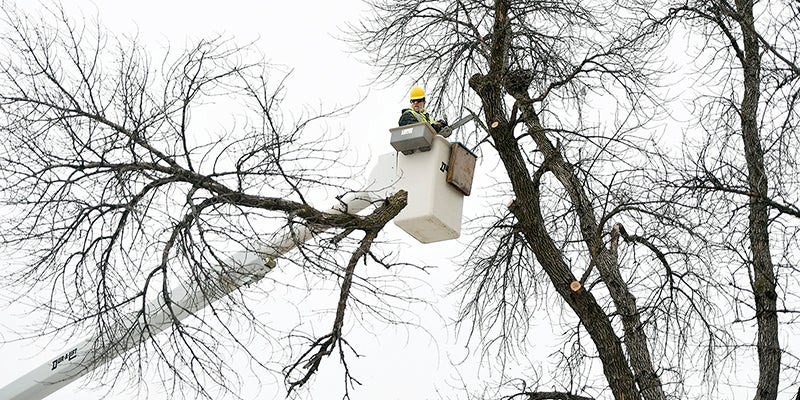Parks and Rec taking ‘treat first’ approach to EAB
Published 6:30 pm Monday, March 25, 2024

- Crews from the City of Austin cut down an ash tree in response to the Emerald Ash Borer in March of last year. However, Parks, Recreation and Forestry is now taking a treat-first approach to the issue. Herald file photo
|
Getting your Trinity Audio player ready...
|
Public information meeting slated for April 9
A new team, formed within the Austin Parks, Recreation and Forestry Department, is taking an action-oriented approach to the Emerald Ash Borer present in the community that they hope will save more ash trees in the end.
The team, which consists of new Parks and Recreation Director Jason Sehon, Parks and Forestry Supervisor Randy Hoffner, Jay C. Hormel Nature Center Director Luke Reese and Kris Hahn and Jenna Kaiser of the Climate Impact Corps, is developing a plan that would not only help save ash trees on city property, but that would also help guide landowners with their own trees.
This approach is simple: Treat now.
“We’re trying to get that message out there in the community,” Sehon said Monday. “What we’re beginning to realize is that ash trees that are treatable this spring and summer, most likely will not be treatable next year. They will be too far gone. The window is closing quickly.”
To date, the group has identified 250 trees out of the roughly 2,000 on city property that are treatable. A grant from The Hormel Foundation for $40,000, with a required matching grant from the department, will put $80,000 toward a program of treating, removing or replacing trees.
Sehon said that they will soon be sending out requests for proposals to treat those over 200 trees with plans to continue into the summer.
“We’re doing this first group of 250 trees now and then toward the end of April, early May, we’re going to identify as many treatable trees as we can and we’re going to use as much of that grant funding as we can to treat trees.”
Sehon went on to say that he will confer with Hoffner on what to do about any remaining funds, which could be put toward either removal of infected trees or planting of new trees.
This is where the importance of treating trees now crosses with an effort to help property owners as much as possible in treating their own trees.
Current weather conditions are crimping efforts by Parks and Rec to plant new trees, however, there is a more simplified path by helping property owners.
“The problem with planting right now is the drought situation,” Sehon said, adding that there are 3,000 ash trees on private property throughout Austin. “We don’t really have the resources to get out there and water and care for these (new) trees, so we’re actively looking for funding to help residents on this note.”
“The city can’t plant right now. Residents probably can,” Sehon continued. “They can care for them easier than the city can care for them.”
To that end, Sehon said that the department is looking at a special arbor day event that could put new trees in the hands of residents.
They are also holding a public information meeting at 6 p.m. on April 9 at the Jay C. Hormel Nature Center that will allow the department to get information out into the community and to property owners.
Information is also available through handouts at the Parks, Recreation and Forestry office.
Not only will this information help landowners on the proper identification of ash trees in the first place, but it will also help them identify whether or not their tree is infested with EAB.
The department is also working to secure the same treatment cost for property owners as it is for city-owned trees when the time comes.
“We are asking them to pass on that cost to homeowners,” he said. “We’re trying to do our best to help property owners at the same time.”
The department has also received a separate grant for around $20,000 to help formulate an EAB plan that includes working with a tree services company that will have information from throughout the cycle including treating, removal and replanting.
All of this is being worked on underneath a tight time frame, however. The best time to treat a tree is in the spring, between May 1 and June 30. Anything after begins to erode the chances of saving the tree, something the Parks and Recreation Department firmly wants to avoid.
In Austin, 20% of trees are ash trees. Cutting those trees down will create a noticeable effect within the community.
“The treatment has been proven to work,” Sehon said. “We feel pretty confident we’re not just throwing money away.”
Meanwhile, crews continue to take down trees that are too far gone in the community. When an ash tree dies, it deteriorates quickly and becomes brittle, making it a safety hazard.
Sehon also said that he is looking for grant options that could help those from lower incomes or with disabilities remove their trees when needed.
In the more immediate future, though, Sehon feels good that this path is among the best options for preserving as many trees as possible in Austin.
“We just want to save as many trees as we can and we think this is the year to do it,” he said, adding that there is a possibility in the future to take on the task internally. “We’re looking at purchasing equipment and getting the certification for our staff necessary to treat trees ourselves.”




